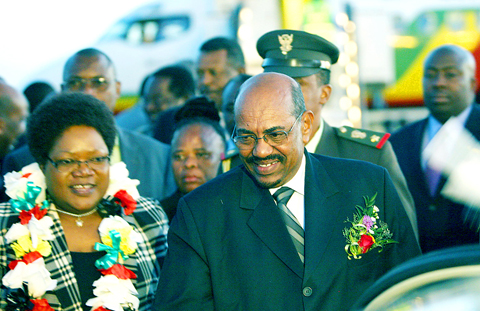Africa’s main trading bloc was to open a summit yesterday to launch a customs union that will stretch across the continent in a bid to boost regional trade.
Under the deal, the 19 countries in the Common Market for Eastern and Southern Africa (COMESA) will impose the same tariffs on goods from outside the region.
Raw materials and capital goods will travel across borders without tariffs, while intermediate products will be taxed at 10 percent and finished goods at 25 percent.

PHOTO: AFP
Most countries have also lifted visa restrictions on travel within the bloc, with members ranging from tourist hotspot Egypt to some of the world’s poorest and most conflict-torn nations, like the Democratic Republic of Congo.
The COMESA region is home to 400 million people, with a combined GDP of US$360 billion.
Leaders hope the union will simplify trade across the region and provide the basis for strengthening integration in the future, eventually leading to a single currency.
“The customs union will therefore enable us to grow beyond the free movement of goods and establish the foundations of a single market,” Zimbabwean Prime Minister Morgan Tsvangirai told business leaders ahead of the summit in the resort town of Victoria Falls.
“It will offer a more predictable economic environment for both investors and traders across the COMESA region,” he said.
The launch of the union had been set for May last year, but was twice delayed because of Zimbabwe’s political turmoil and to allow more time for the 19 member countries to negotiate the harmonization of tariffs.
Officials say COMESA has already succeeded in increasing trade within Africa, which historically has exported most of its raw materials to rich countries with little commerce within the continent.
Kenyan Trade Minister Amos Kimunya said trade within the bloc had increased fivefold over the past decade, from US$3 billion to US$15 billion.
“The COMESA market is now the No. 1 export market for several members states, ahead of traditional export markets such as the European Union,” Kimunya said.
But some economists doubt that the customs will change Africa’s traditional trade patterns.
“African states don’t trade among themselves,” said Bongani Motsa, an economist at the Pan African Advisory Service financial consultancy. “If you look at the trading account, African states trade in primary products which they mostly export to the European Union, and then they import high value products from other international countries.”
COMESA comprises Burundi, Comoros, Djibouti, the Democratic Republic of Congo, Egypt, Eritrea, Ethiopia, Kenya, Libya, Madagascar, Malawi, Mauritius, Rwanda, Seychelles, Sudan, Swaziland, Uganda, Zambia and Zimbabwe.

STILL COMMITTED: The US opposes any forced change to the ‘status quo’ in the Strait, but also does not seek conflict, US Secretary of State Marco Rubio said US President Donald Trump’s administration released US$5.3 billion in previously frozen foreign aid, including US$870 million in security exemptions for programs in Taiwan, a list of exemptions reviewed by Reuters showed. Trump ordered a 90-day pause on foreign aid shortly after taking office on Jan. 20, halting funding for everything from programs that fight starvation and deadly diseases to providing shelters for millions of displaced people across the globe. US Secretary of State Marco Rubio, who has said that all foreign assistance must align with Trump’s “America First” priorities, issued waivers late last month on military aid to Israel and Egypt, the

France’s nuclear-powered aircraft carrier and accompanying warships were in the Philippines yesterday after holding combat drills with Philippine forces in the disputed South China Sea in a show of firepower that would likely antagonize China. The Charles de Gaulle on Friday docked at Subic Bay, a former US naval base northwest of Manila, for a break after more than two months of deployment in the Indo-Pacific region. The French carrier engaged with security allies for contingency readiness and to promote regional security, including with Philippine forces, navy ships and fighter jets. They held anti-submarine warfare drills and aerial combat training on Friday in

COMBAT READINESS: The military is reviewing weaponry, personnel resources, and mobilization and recovery forces to adjust defense strategies, the defense minister said The military has released a photograph of Minister of National Defense Wellington Koo (顧立雄) appearing to sit beside a US general during the annual Han Kuang military exercises on Friday last week in a historic first. In the photo, Koo, who was presiding over the drills with high-level officers, appears to be sitting next to US Marine Corps Major General Jay Bargeron, the director of strategic planning and policy of the US Indo-Pacific Command, although only Bargeron’s name tag is visible in the seat as “J5 Maj General.” It is the first time the military has released a photo of an active

CHANGE OF MIND: The Chinese crew at first showed a willingness to cooperate, but later regretted that when the ship arrived at the port and refused to enter Togolese Republic-registered Chinese freighter Hong Tai (宏泰號) and its crew have been detained on suspicion of deliberately damaging a submarine cable connecting Taiwan proper and Penghu County, the Coast Guard Administration said in a statement yesterday. The case would be subject to a “national security-level investigation” by the Tainan District Prosecutors’ Office, it added. The administration said that it had been monitoring the ship since 7:10pm on Saturday when it appeared to be loitering in waters about 6 nautical miles (11km) northwest of Tainan’s Chiang Chun Fishing Port, adding that the ship’s location was about 0.5 nautical miles north of the No.